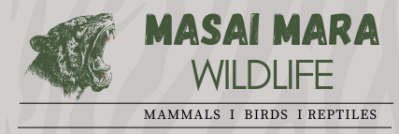- Common Names: Golden Jackal, Bweha dhahabu (Swahili), Bweha wa mbuga (Swahili), Embarie (Maasai)
- Scientific Name: Canis aureus
- Size:
- Head-Body Length (HBT): 145 cm (57 inches)
- Shoulder Height (SH): 45 cm (18 inches)
- Gestation: 9–10 weeks
- Recognition: The Golden Jackal is larger and more wolf-like than other jackal species found in the Masai Mara, with a muscular build and broader muzzle. Its coat is grizzled and variable in color, but it lacks the distinctive black saddle of the Black-backed Jackal. The tail is uniformly dark, adding to its distinguishing features.
Habits and Behavior
- Diurnal and Nocturnal: Golden Jackals are primarily active at night but are also commonly seen during the cooler parts of the day, making them more adaptable to different conditions. They move with a purposeful trot, often pausing to leap onto prey. Their adaptability makes them one of the more versatile predators in the Masai Mara.
- Efficient Hunters and Opportunistic Scavengers: While they are capable hunters, Golden Jackals are opportunistic feeders. Their diet includes everything from small vertebrates to scavenged carcasses. They are known for targeting young or sick animals and even scavenging afterbirth from Wildebeests. Their omnivorous diet includes fruits, birds, small mammals, reptiles, and invertebrates, making them highly versatile in their foraging behaviors.
Social Structure
- Monogamous and Territorial: Golden Jackals form strong monogamous pairs and are territorial. They establish home ranges which they defend vigorously, especially from rival jackals or predators. Their ability to adapt to a variety of habitats, from the savannas of East Africa to the deserts of the Middle East and India, demonstrates their versatility in thriving in diverse environments.
Diet
- Feeds on: Golden Jackals have an omnivorous diet, ranging from fruits and invertebrates to birds, reptiles, and small mammals. They are adept at scavenging, often feeding on carrion and other leftover kills, and have been observed consuming Wildebeest afterbirth during calving season. Their diet flexibility helps them survive in varying conditions.
Habitat
- Where to Find: Golden Jackals are widespread across the Masai Mara, inhabiting open areas like short to medium grasslands, rocky semi-deserts, and even regions near water sources. While they are more likely found in open plains, their ability to thrive in diverse habitats has allowed them to range far beyond Africa, extending through the Middle East and into parts of South Asia.
Conservation Status
- IUCN Status: Least Concern. The Golden Jackal has a wide distribution, ranging from East Africa through North Africa and the Middle East, all the way to Southeast Asia. Their population is stable, thanks to their adaptability to different environments and omnivorous diet. However, as with many species, habitat encroachment and human-wildlife conflict can pose future threats, particularly in areas where their natural habitats overlap with human settlements.
Unique Traits
- Versatile Diet and Behavior: The Golden Jackal’s generalist nature allows it to adapt to a wide range of environments. This ability to consume a variety of food sources, including fruits, invertebrates, and scavenged meat, is a key factor in its survival.
- Broader Geographic Range: Unlike the Black-backed and Side-striped Jackals, which are primarily restricted to Africa, the Golden Jackal has a much wider distribution, extending from northern Tanzania to Southeast Asia.
- Muscular Build and Distinctive Appearance: Compared to other jackals, the Golden Jackal has a more wolf-like appearance, with a broader muzzle and muscular proportions. Its grizzled coat and dark tail make it easily recognizable.
Interesting Facts
- Widespread Success: The Golden Jackal is the only jackal species that is not endemic to Africa. Its wide geographic range demonstrates its impressive adaptability, thriving in ecosystems from African savannas to Asian forests.
- Resourceful Scavenger: Golden Jackals are highly resourceful when it comes to finding food. They are known to scavenge for meat at carcasses and opportunistically feed on any available resource, such as fruits, insects, or small mammals.
In conclusion, the Golden Jackal is a resilient and adaptable predator in the Masai Mara. With its wide-ranging diet, strong monogamous bonds, and muscular build, it thrives across diverse habitats. Listed as Least Concern by the IUCN, this versatile carnivore continues to flourish across a broad geographical range, from Africa to Asia.
